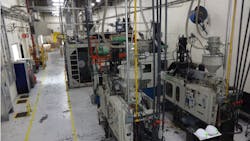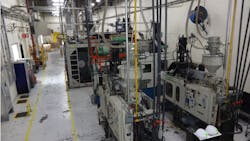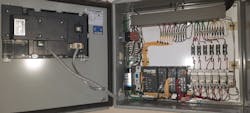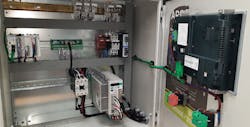Rapid Automation Deployment Requires Cooperation
Top companies in any industry are constantly striving to improve flexibility and responsiveness for their stakeholders. Oftentimes, this requires some degree of professional support from outside the company, particularly for specialized manufacturing services.
With more than 50 years of experience manufacturing products for a diverse group of customers and markets, Keytronic provides plastic injection molding, printed circuit board assembly, metal fabrication, and full product assembly services for almost any volume mix and degree of complexity. The company and its team members strive to maintain an external focus on customers, using innovative practices and procedures to deliver superior performance. Most customers are in the computer, telecommunication, medical, automotive, aerospace, consumer and industrial markets (Fig. 1).
As a technical services company, Keytronic must also address its own manufacturing automation challenges, quite often through the efforts of internal personnel most familiar with the processes and required level of performance. Towards this end, the Keytronic team has identified and is progressively deploying a portfolio of commercial off-the-self automation products, updating and developing systems across several locations to optimize production while saving money.
Constant Change
Because Keytronic performs a wide variety of industrial manufacturing and assembly tasks, it uses an equally diverse amount of machinery and material handling equipment. Various OEMs supply different automation platforms and technologies, and the company must integrate these systems both upstream and downstream, coordinating material transfer among them. Legacy systems can be decades old and in need of a refresh, while new systems may arrive with some degree of automation or could be procured as basic equipment requiring the addition of automation systems.
The company produces many different products for unique clients and constantly adds new designs to the mix. Production details and demands vary, sometimes quite rapidly, and a production run could be as short as 400 pieces taking about 30 min. to produce, or an ongoing long-term endeavor. Therefore, all production systems must be capable of quick changeovers, and solutions also need to be multi-language capable for best usability by a diverse workforce.
Manufacturing Successes
Sometimes the projects at hand can be as small as adding a sensor to a machine to improve reliable operation or retrofitting a new controller on individual equipment to enhance functionality. In some cases, the target equipment isn’t used for production but instead performs testing or quality control functions. Other times the work encompasses more tasks, such as coordinating and integrating various systems to optimize throughput.
This means there is great variability in the types of hardware and software needed. Products chosen for these tasks obviously need to meet certain performance requirements, but other important factors for the technical team included specifying products that:
- Are readily available.
- Easy to configure.
- Come with solid documentation and support.
- Deliver excellent reliability.
- Provide a good price/performance ratio.
Because almost all the work is performed in house with a relatively small group of three people, keeping things simple and effective is paramount. The group supports three main facilities: a blow molding plant, a metal preforming facility and an assembly line operation. Successfully performing the immediate task at hand is vital, as is selecting solutions that can be scaled up and deployed throughout other systems, multiplying the value.
For these and other reasons, the team quickly standardized on a complete portfolio of AutomationDirect products because this supplier offers almost every conceivable item needed to create automation and data handling projects. The hardware and software invariably meet all project expectations, and it is particularly important that the products are not complicated to use and program.
Early projects performed by the team were based on classic automation elements like PLCs and HMIs (Fig. 2). Two examples are a resin loading system (for transporting resin pellets from bulk sources to the destination equipment) and a blow molder (which required multiple zone PID temperature control). The team developed the control logic to meet their specific conditions, and they configured the displays to provide exactly what their operators needed, with extensive help messages and multi-language capability (Fig. 3).
In practice, the automation products have provided a high level of reliability, and the positive results mean the team will continue to build new solutions using these devices.
Projects have become more ambitious, incorporating servo control, more modern controllers with expansive communications capabilities and much more (Fig. 4). The automation work can progress at a pace that makes sense for the development team and for operations. For example, a servo control system is used to feed a roll of metal plate into a die cutting press at high speed, so material can be cut rapidly but with a precision on the order of thousandths of an inch. The short-term plan is to monitor and adjust this machine remotely. More elaborate strategies and capabilities can be added in the future.
Agile Automation
Some manufacturing operations are designed, built, and then go into regular and consistent production for years. However, there are an increasing number of facilities which need the ability to generate a widely varying product mix, and sometimes deliver customization so individualized that a production run lot size may be just a few items.
Manufacturing relies on the quality, efficiency and economy delivered by automation in favor of purely manual processes. Creating effective automation systems is a specialty, so many manufacturers must lean on OEMs and external firms to provide these services, making it difficult or costly to make changes once systems are in operation. To address these and other issues, Keytronic creates, installs and supports automation systems in house.
Comprehensive suppliers like AutomationDirect make it easier for manufacturers to control their own destiny by performing some or much of the work themselves, exactly meeting the needs of internal operators and external customers. Keytronic has found great success using this approach to perform automation work internally in an agile fashion. By standardizing on the comprehensive portfolio, Keytronic consistently automates with new technology to maintain and increase productivity, safety and on-time deliveries to customers while carefully controlling costs.
Jose Luis Rodriguez Persona is a senior maintenance and integration supervisor at Keytronic. He designs automation for new equipment and to improve existing machines to solve specific challenges, providing personalized production support for clients and increasing worker safety. He has nearly 30 years of industry experience with automatic control of material handling systems, servos, robotic and heavy machinery automation.
About the Author
Jose Luis Rodriguez Persona
Senior Maintenance and Integration Supervisor, Keytronic
Jose Luis Rodriguez Persona is a senior maintenance and integration supervisor at Keytronic. He designs automation for new equipment and to improve existing machines to solve specific challenges, providing personalized production support for clients and increasing worker safety. He has nearly 30 years of industry experience with automatic control of material handling systems, servos, robotic and heavy machinery automation.




